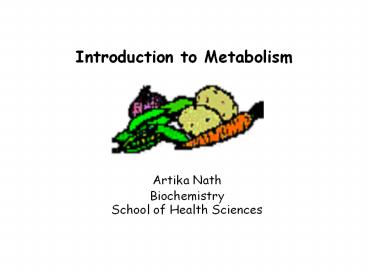Introduction to Metabolism - PowerPoint PPT Presentation
1 / 16
Title:
Introduction to Metabolism
Description:
Introduction to Metabolism Artika Nath Biochemistry School of Health Sciences Objectives We are now going to look at two major questions in Biochemistry How do cells ... – PowerPoint PPT presentation
Number of Views:722
Avg rating:3.0/5.0
Title: Introduction to Metabolism
1
Introduction to Metabolism
- Artika Nath
- Biochemistry
- School of Health Sciences
2
Objectives
- We are now going to look at two major
questions in Biochemistry - How do cells extract energy from their
environment - How do cells synthesize the building blocks of
their macromolecules - This leads to the study of
3
Metabolism
- Is the sum total of all chemical reactions
involved in maintaining the living state of the
cells, and thus the organism.
- Divided into two categories
- Catabolism break down of molecules to obtain
energy - Anabolism- the synthesis of all molecules needed
by cells - e.g. DNA, protein etc.
4
Thermodynamics of Metabolism
- Metabolic reactions are catalyzed by enzymes and
obey the laws of thermodynamics - (1) First Law of Thermodynamics (conservation of
energy) energy can be transformed from one form
to another but cannot be created nor destroyed.
Energy in the universe is constant. - 2) Second Law of Thermodynamics energy
transformations are never 100 efficient (some
energy is lost as heat)
5
Major purpose living things require energy for
- 1. mechanical work in muscle contraction and
other cellular movement
- 2. Active transport of molecules and ions
- 3. Synthesis of bio-molecules and simple
precursors proteins, glycogen, fat
6
What carries energy????
The energy currency in combustion engines is
heat heat is produced and used to expand the
volume of a gas
- The energy currency or coin of the cell
- Energy rich molecule
- Triphosphate contains 2 phosphoanhydride bonds
The 2 phosphate bonds (phosphoanhydride) bond) is
here the energy is stored in ATP
7
A large amount of energy is liberated when
1.
ATP ? ADP Pi (orthophosphate)
2.
ATP ? AMP PPi (pyrophospahte)
The free energy liberated with the hydrolysis of
ATP is used to drive reactions that require input
f free energy
8
- ATP is continuously formed and consumed
- Its the principal immediate donor and not long
term storage of energy - Rate of turnover of ATP is high. A molecule of
ATP is consumed within a minute it is formed - Resting person consumes 40kg of ATP/ 24 hr.
Motion, Active transport, Biosynthesis, Signal
amplification
ATP
ADP
Photosynthesis or oxidation of fuel molecules
Basic model of energy exchange in biological
systems
9
How do cells make ATP
- By PHOSPHORYLATION... adding a phosphate to
ADP - ADP P ------gt ATP
3 mechanisms of phosphorylation
- substrate level phosphorylation- where a
substrate molecule ( X-p ) donates its high
energy P to ADP making ATP - Oxidative phosphorylation
- e- transferred from organic molecules and
passed through a series of acceptors to O2 - 3. Photophosphorylation
- Occurs during photosynthesis light energy
used to make ATP
10
Electron carriers
- When food molecule oxidized electrons are
removes - These electrons are carried to oxygen
- e-
O2 - ANS Electron carriers
- NAD (nicotinamide adenine dinucleotide) and
- FAD (flavin adenine dinucleotide)
- Reduced form (with electrons bound) is
- NADH and FADH2
- NADH and FADH2 transfer e- to O2 in the
mitochondria by means of ETC gt ATP generated in
this process
How does the e- get to oxygen???????
11
(No Transcript)
12
Stage 1 Large molecules broken int o smaller
units
Stage 2 The numerous small units are degraded to
a few simple units that play a central role in
metabolism. Most re converted to the acetyl unit
of acetyl CoA. Some ATP generated
Stage 3 Kreb cycle and oxidative phosphorylation
Most energy generated here
13
Carbohydrates
- 2-3 of your total body weight
- Monosaccharides the building block
- e.g. glucose (the main energy supplying molecule
of the body - Fructose- found in fruits Galactose present
in milk Deoxyribose in DNA Ribose- RNA - Glycogen main storage (liver and skeletal
muscle) form of carbohydrate. - Starch main carbohydrate in food
- Cellulose- no digested by humans
14
- 18-25 of body weight in lean adults
- Hydrophobic
- Usually combine with proteins (lipoproteins) and
move in the blood - Hydrophobic , so cannot exert osmotic pressure on
cell walls therefore stored easily. - Triglycerides most plentiful lipid in your body.
Each gram can produce twice as much as energy
compared to carbohydrates and proteins - Triglycerides stored unlimited in adipose tissues
15
Proteins
- 12-18 body weight
- Many functions
- catalyst, transport and storage, movement,
structural, immune system and regulatory role - Amino acids building blocks
- Cannot store proteins
16
- What is a polysaccharide? A disaccharide? A
monosaccharide? Give some examples of
monosaccharides. Which monosaccharide does the
body use for energy production? - How is carbohydrate stored in the body?
- What is a polypeptide? A dipeptide? An amino
acid? What distinguishes an amino acid from a
carbohydrate? - What does the body use proteins for?
- What is a triglyceride? A fatty acid? Glycerol?
Name some uses of lipids in the body. How are
excess fatty acids stored in the body? - Define metabolism.
- Distinguish between anabolism and catabolism.
- ATP is the cell's storehouse of energy. Where,
within the ATP molecule, is this energy stored?
Where does that energy come from? - Which of the three nutrients produces more
energy, gram for gram, when oxidized? - What is the difference between glycogenesis and
glycogenolysis?































